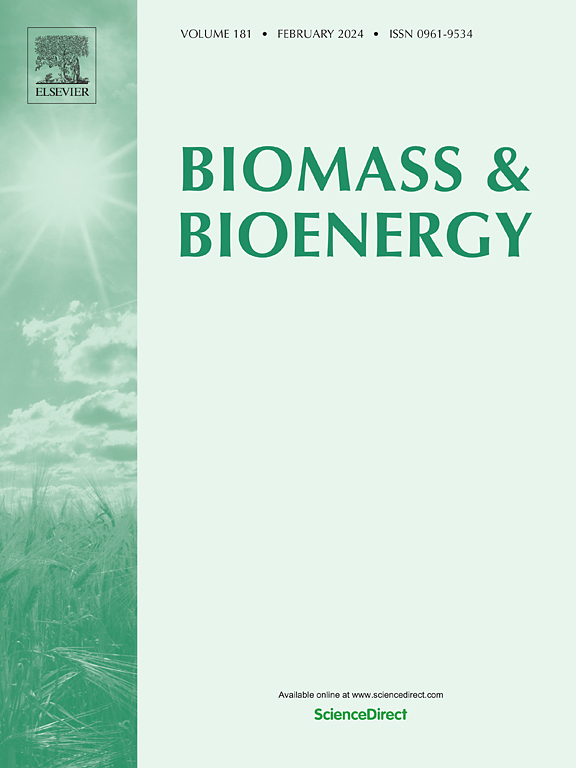Chemical looping reforming of bioethanol for hydrogen production: Modeling and design of the fuel reactor of a 350 MW unit
IF 5.8
2区 生物学
Q1 AGRICULTURAL ENGINEERING
引用次数: 0
Abstract
Chemical Looping Reforming of bioethanol offers an efficient process for the production of high-quality syngas which may be easily integrated with CO2 capture technologies for the H2 production with negative CO2 emissions. In this work, the fuel reactor of a 350 MW Chemical Looping Reforming unit, fed with raw ethanol obtained after the first distillation, has been modeled. A macroscopic model was developed by integrating the fluid dynamics of a high-velocity fluidized bed with the kinetics of catalytic ethanol conversion. The Ni-based oxygen carrier exhibited sufficient catalytic activity and oxygen transport capacity to fully convert ethanol, with CO and H2 as the main gas products. Simulation work was done to evaluate the syngas production as a function of the operating conditions. Eventually, the basic parameters for the design of the fuel reactor are defined. Results from mass and enthalpy balances indicated that suitable conditions to maximize syngas yield (4.3 mol H2 per mole of bioethanol after WGS reactor) included a solids circulation of 1000 kg/s and a fuel reactor temperature of 800 °C. To support a suitable fluid dynamic, the cross area was fixed at 0.05 m2/MW, which defined an inlet gas velocity of 5.6 m/s and supported the desired solids circulation rate. The fuel reactor was set at 13.6 m height to accommodate the size of four cyclones, and a pressure drop value of 24 kPa is proposed to facilitate a suitable dense bed height of 0.5 m.

生物乙醇制氢化学环重整:350mw机组燃料反应器的建模与设计
生物乙醇的化学环重整为生产高质量合成气提供了一种有效的工艺,这种合成气可以很容易地与二氧化碳捕获技术相结合,以生产负二氧化碳排放的氢气。在这项工作中,350mw化学循环重整装置的燃料反应器,以一次蒸馏后得到的原料乙醇为原料,进行了建模。将高速流化床流体动力学与催化乙醇转化动力学相结合,建立了宏观模型。镍基氧载体表现出足够的催化活性和输氧能力,可以完全转化乙醇,主要气体产物为CO和H2。对合成气产量随操作条件的变化进行了仿真研究。最后,确定了燃料堆设计的基本参数。质量和焓平衡结果表明,固体循环1000 kg/s,燃料反应器温度800℃,可以最大限度地提高合成气产量(每摩尔生物乙醇4.3 mol H2)。为了支持合适的流体动力学,将交叉面积固定在0.05 m2/MW,这定义了入口气体速度为5.6 m/s,并支持所需的固体循环速率。燃料堆高度设置为13.6 m,以适应4个旋风的大小,建议压降值为24 kPa,以方便0.5 m的适宜密床高度。
本文章由计算机程序翻译,如有差异,请以英文原文为准。
求助全文
约1分钟内获得全文
求助全文
来源期刊

Biomass & Bioenergy
工程技术-能源与燃料
CiteScore
11.50
自引率
3.30%
发文量
258
审稿时长
60 days
期刊介绍:
Biomass & Bioenergy is an international journal publishing original research papers and short communications, review articles and case studies on biological resources, chemical and biological processes, and biomass products for new renewable sources of energy and materials.
The scope of the journal extends to the environmental, management and economic aspects of biomass and bioenergy.
Key areas covered by the journal:
• Biomass: sources, energy crop production processes, genetic improvements, composition. Please note that research on these biomass subjects must be linked directly to bioenergy generation.
• Biological Residues: residues/rests from agricultural production, forestry and plantations (palm, sugar etc), processing industries, and municipal sources (MSW). Papers on the use of biomass residues through innovative processes/technological novelty and/or consideration of feedstock/system sustainability (or unsustainability) are welcomed. However waste treatment processes and pollution control or mitigation which are only tangentially related to bioenergy are not in the scope of the journal, as they are more suited to publications in the environmental arena. Papers that describe conventional waste streams (ie well described in existing literature) that do not empirically address ''new'' added value from the process are not suitable for submission to the journal.
• Bioenergy Processes: fermentations, thermochemical conversions, liquid and gaseous fuels, and petrochemical substitutes
• Bioenergy Utilization: direct combustion, gasification, electricity production, chemical processes, and by-product remediation
• Biomass and the Environment: carbon cycle, the net energy efficiency of bioenergy systems, assessment of sustainability, and biodiversity issues.
 求助内容:
求助内容: 应助结果提醒方式:
应助结果提醒方式:


